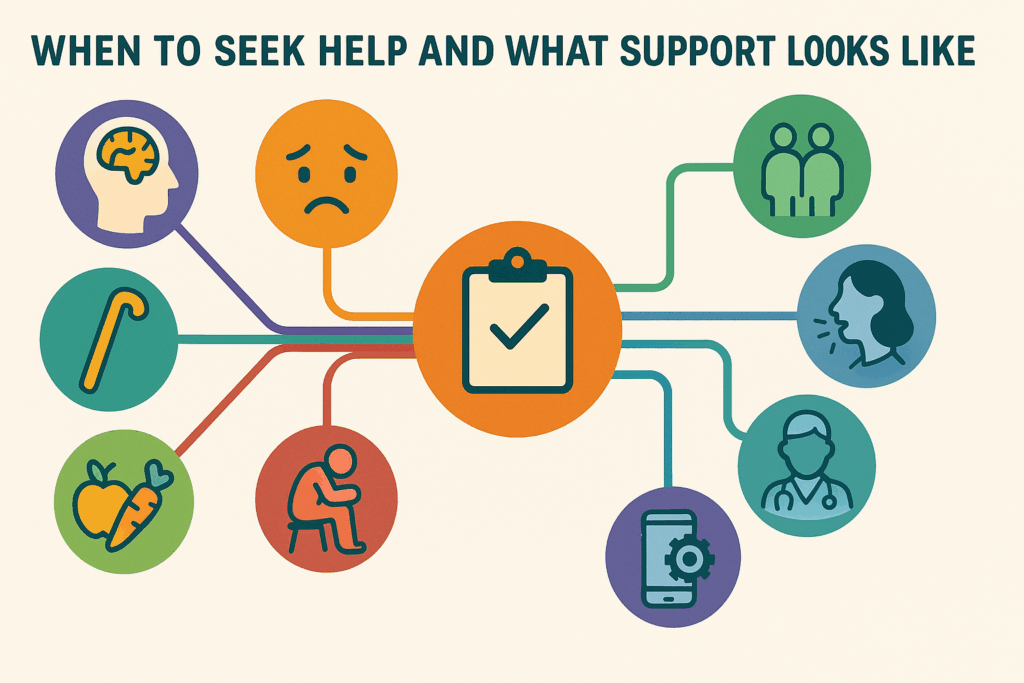Aging is an inevitable journey, yet its course varies vastly among individuals. For many older adults, the transition into later life may unfold gently and gracefully. However, for others, this stage brings more noticeable changes that may indicate a deeper shift in cognitive, emotional, or physical well-being. While some transformations are expected, others may point to emerging health concerns that require timely intervention. Understanding the subtle signs of decline in elderly individuals is critical, not only for early detection of medical issues but also for fostering a better quality of life. This article delves into how these signs manifest, what they may signify, and when they call for professional support.
You may also like: How to Prevent Dementia and Alzheimer’s Disease Naturally: Expert-Backed Strategies to Reduce Your Risk Through Lifestyle and Diet

Differentiating Normal Aging from Concerning Changes
The natural aging process involves various physiological changes such as slower metabolism, mild memory lapses, and reduced muscle strength. These shifts are typically gradual and do not necessarily interfere with a person’s ability to live independently or engage meaningfully with others. However, when these changes begin to affect day-to-day functioning, it may be time to consider whether they reflect deeper concerns. Recognizing the difference between normal aging and the more subtle signs of decline in elderly adults requires close attention, empathy, and sometimes, medical assessment.
One of the key challenges families face is differentiating between age-appropriate forgetfulness and more serious cognitive deterioration. Occasionally misplacing items or momentarily forgetting names can be typical in older age. But consistent difficulty with familiar tasks, disorientation, or frequent repetition may suggest a need for further evaluation. These signs of deterioration in elderly individuals can be early indicators of conditions like dementia, which benefit from early diagnosis and intervention.

Behavioral and Emotional Shifts That May Signal Concern
Among the first signs of decline in elderly adults are changes in behavior and emotional regulation. Subtle withdrawal from social engagements, loss of interest in hobbies, or increased irritability might easily be attributed to mood or personality. Yet these changes can sometimes reflect underlying mental health issues or even early signs of neurodegeneration. Depression and anxiety often present differently in older adults compared to younger individuals. Instead of overt sadness or worry, symptoms might manifest as apathy, restlessness, or somatic complaints such as chronic pain and fatigue.
Paying attention to such emotional shifts is especially important because mental health often receives less attention in aging populations. For instance, an elderly parent who begins to avoid family gatherings or expresses hopelessness about the future may not just be reacting to loneliness but may be exhibiting signs of deterioration that merit medical attention. Emotional resilience can wane in the face of physical illness, social isolation, or grief, making it vital to address both psychological and physical well-being in tandem.

Cognitive Warning Signs That Go Beyond Forgetfulness
Cognition encompasses more than just memory; it includes judgment, attention, language, and problem-solving abilities. When these faculties begin to falter, it can signal significant underlying issues. Repeated confusion about time or place, difficulty following conversations, or challenges in planning activities may all be early cognitive red flags. In many cases, such signs of deterioration in elderly individuals go unnoticed or are downplayed until they become severe enough to cause disruptions in daily life.
Unlike the occasional forgetfulness that can accompany normal aging, these symptoms suggest a deviation from baseline function. For example, someone who once managed household finances with ease but now struggles with simple transactions may be facing more than mere distraction. These signs of decline in elderly people often precede diagnoses such as mild cognitive impairment (MCI) or Alzheimer’s disease. Timely evaluation by a neurologist or geriatric specialist can help clarify the cause and initiate appropriate care strategies.

Physical Decline as an Indicator of Broader Issues
Physical decline is often more apparent than cognitive changes, yet it too can be deceptively gradual. A noticeable reduction in mobility, increased frailty, frequent falls, or difficulty performing everyday tasks such as dressing or bathing may signal more than age-related wear and tear. These signs of decline in elderly adults frequently indicate functional impairments that can compromise independence and safety.
Gait changes and balance issues may hint at neurological problems such as Parkinson’s disease or stroke, while persistent fatigue could signal anemia, thyroid dysfunction, or heart failure. The presence of unexplained bruises or injuries might point to undiagnosed conditions that affect strength or coordination. Importantly, physical signs of deterioration in elderly individuals should never be accepted as a normal part of aging without proper medical evaluation, as early intervention can often prevent further decline.
Social Disengagement and Loss of Initiative
Social isolation is a significant but often overlooked marker of mental and cognitive health in aging adults. When an older individual begins to withdraw from community involvement, family connections, or previously enjoyed activities, it can serve as a strong indicator of declining mental or physical capacity. This social disengagement may stem from multiple sources, including hearing loss, vision impairment, mobility limitations, or mood disorders.
Lack of initiative or a passive attitude toward once-enjoyed activities is another subtle yet telling sign. An elderly person who no longer maintains hobbies, skips meals, or avoids simple grooming routines may be exhibiting early signs of deterioration. These changes often go unrecognized until they compound into more serious functional or emotional deficits. Encouraging consistent social interaction and routine-based engagement can serve as protective factors against further decline.

Communication Difficulties and Language Decline
Language is a fundamental aspect of human connection, and when it begins to deteriorate, it can affect relationships, independence, and quality of life. Elderly adults may begin to struggle with finding the right words, repeating themselves frequently, or becoming easily confused during conversations. While occasional lapses are common, consistent issues with language production or comprehension may be early signs of neurodegenerative conditions such as primary progressive aphasia or Alzheimer’s disease.
These language-related signs of decline in elderly individuals often appear before other more recognizable symptoms, making them crucial early indicators. Difficulty with written language, trouble understanding verbal instructions, or frequent reliance on nonspecific words such as “thing” or “that” can all signify deeper problems. Speech-language pathologists can provide valuable assessments and interventions to support communication skills and slow progression.
Unintentional Weight Loss and Nutritional Neglect
Nutrition plays a foundational role in supporting cognitive and physical health, and any marked deviation in dietary habits among older adults deserves close attention. Unexplained weight loss, reduced appetite, or a noticeable decline in food preparation and consumption routines can be early signs of deterioration in elderly populations. These symptoms may arise from dental issues, gastrointestinal disorders, depression, or diminished sensory perception of taste and smell.
Moreover, cognitive decline itself may contribute to poor nutrition. An older adult might forget to eat, prepare unsafe meals, or repeatedly consume the same limited foods. In some cases, a reluctance to shop for groceries or confusion about cooking can result in nutrient deficiencies, particularly in vitamins B12 and D, which are essential for brain function. Addressing these nutritional concerns early can prevent cascading health complications and promote better overall resilience.
Changes in Sleep Patterns and Circadian Rhythms
Sleep disturbances are common in aging, but certain patterns may signal underlying health problems rather than benign shifts in circadian rhythm. Difficulty falling asleep, waking frequently during the night, or excessive daytime sleepiness should not be dismissed as simple aging issues. Instead, they may reflect early signs of decline in elderly adults, particularly when sleep disruptions are accompanied by confusion, mood changes, or altered behavior.
Conditions such as sleep apnea, restless leg syndrome, or even early-stage dementia can manifest primarily through sleep-related symptoms. These disturbances can also exacerbate existing cognitive and emotional issues, creating a feedback loop of decline. Interventions such as sleep hygiene education, treatment for underlying disorders, and structured daily routines can make a significant difference in maintaining cognitive and emotional stability.

Mismanagement of Medications and Healthcare Tasks
Older adults often manage multiple medications, appointments, and health-related responsibilities. When these tasks become confusing or neglected, it may suggest emerging cognitive or functional decline. Forgetting to take medications, doubling doses, or missing medical appointments are not just logistical issues—they are frequently early signs of deterioration in elderly individuals.
Families and caregivers should be particularly alert to signs of disorganization in medication management, as this can quickly lead to medical emergencies. Tools such as pill organizers, reminder systems, and caregiver oversight can help prevent errors, but persistent issues often indicate a need for broader cognitive assessment. Addressing these problems early can help preserve autonomy and reduce the risk of preventable health crises.
Financial Mismanagement and Safety Risks
Diminished capacity to manage finances is another early and often overlooked indicator of cognitive decline. An elderly adult who begins to forget to pay bills, fall for financial scams, or misplace large sums of money may be experiencing more than simple forgetfulness. These signs of decline in elderly individuals can result in severe consequences, including eviction, utility shut-offs, or vulnerability to exploitation.
In some cases, subtle errors such as bounced checks or repetitive spending patterns serve as red flags for deeper cognitive or emotional issues. Financial neglect may stem from confusion, impulsivity, or loss of judgment—all of which warrant further evaluation. Families should approach this sensitive issue with care, promoting safety while preserving dignity and independence whenever possible.

When to Seek Help and What Support Looks Like
Determining when to seek professional help can be challenging, especially when changes appear gradually or are easy to rationalize. However, when multiple domains of functioning begin to decline—whether cognitive, emotional, physical, or social—a comprehensive evaluation becomes essential. Geriatricians, neurologists, psychiatrists, and primary care providers all play important roles in diagnosing and managing conditions that cause or contribute to signs of deterioration in elderly adults.
Early intervention not only improves quality of life but can also delay the progression of many age-related conditions. From medication adjustments to occupational therapy, social services to mental health counseling, the spectrum of support available to older adults and their families is vast. Empowering families with knowledge and access to these resources is a key step in ensuring aging adults receive the care and dignity they deserve.
Frequently Asked Questions: Understanding and Managing the Signs of Decline in Elderly Adults
1. How can family members differentiate between temporary setbacks and early signs of decline in elderly individuals?
Temporary setbacks—like fatigue after an illness or a short bout of forgetfulness due to stress—are often self-limiting and resolve on their own. In contrast, persistent changes that affect multiple areas of daily life may signal more serious concerns. For instance, if an older adult consistently struggles with recalling recent conversations, managing bills, or navigating familiar environments, these may be early signs of decline in elderly individuals rather than isolated incidents. Families should look for patterns and duration of changes rather than isolated episodes. Consulting with a geriatric specialist can help determine if what you’re witnessing is a natural part of aging or a sign of deterioration in elderly functioning.
2. What role do environmental factors play in contributing to signs of deterioration in elderly adults?
Environmental factors can significantly influence the manifestation and progression of both cognitive and physical decline. Poor lighting, excessive noise, cluttered living spaces, or lack of mobility aids can exacerbate existing vulnerabilities. In some cases, an elder may appear to exhibit signs of decline in elderly routines simply because their environment is no longer supportive of their needs. Making targeted adjustments—such as installing grab bars, optimizing kitchen layouts, or enhancing sensory stimulation—can alleviate the perception of deterioration and support functional independence. Identifying whether a behavioral change stems from environment or health is crucial for early and accurate intervention.
3. Are there any overlooked emotional signs of deterioration in elderly individuals that families should watch for?
Yes, subtle emotional changes are often underrecognized yet may precede more obvious physical or cognitive symptoms. For example, a once-cheerful individual becoming increasingly irritable, withdrawn, or apathetic might not simply be expressing mood variation—they may be exhibiting emotional signs of decline in elderly well-being. Emotional flatness, inappropriate laughing or crying, or sudden pessimism about the future may also suggest neurological changes. These shifts can be early indicators of frontotemporal disorders or mood-related cognitive impairment. Emotional expression should always be evaluated within the larger context of personality, history, and lifestyle changes.
4. How do sleep disturbances relate to early signs of decline in elderly adults?
Disruptions in sleep are more than just a symptom of aging—they often serve as early biological warning signals. Conditions such as REM sleep behavior disorder, for instance, are now being studied as potential precursors to Parkinson’s and Lewy body dementia. Chronic insomnia, excessive daytime napping, or sleep fragmentation may interfere with memory consolidation and mood regulation, amplifying signs of deterioration in elderly cognition. Sleep studies can reveal underlying problems such as apnea or restless leg syndrome, which may contribute to cognitive load. Early diagnosis and sleep-focused interventions may delay or mitigate further decline.
5. Can technological tools help monitor or mitigate signs of decline in elderly adults?
Absolutely. Advances in health technology have created a suite of tools that can support both monitoring and intervention. Wearables can track sleep, movement, and heart rate irregularities that might precede physical signs of deterioration in elderly adults. Cognitive training apps and telehealth platforms also provide stimulation and connection, reducing the risk of isolation-induced decline. Smart pill dispensers and emergency response systems improve medication adherence and safety. When combined with routine clinical checkups, technology serves as a powerful ally in the early identification and management of subtle declines.
6. What are the financial implications of ignoring early signs of decline in elderly individuals?
Delaying attention to the signs of decline in elderly adults can result in costly outcomes, both financially and emotionally. Missed medication doses, forgotten bills, or susceptibility to scams can rapidly deplete resources. Emergency room visits, long-term hospitalization, or early placement in assisted living often come at a premium. Proactive planning based on early identification of signs of deterioration in elderly adults allows for more affordable, community-based support solutions. Moreover, establishing financial guardianship or power of attorney ahead of time can prevent exploitation and preserve dignity.
7. Are there lifestyle interventions that can slow down signs of deterioration in elderly adults?
Yes, lifestyle choices play a critical role in delaying both cognitive and physical decline. Evidence-based interventions include regular aerobic and resistance exercise, a Mediterranean-style diet, cognitive engagement through reading or puzzles, and consistent social interaction. These habits may not reverse signs of decline in elderly individuals once severe, but they can delay onset and slow progression. For example, resistance training has been linked to improved executive function, and omega-3 intake supports memory retention. Integrating these practices into daily routines offers a preventive buffer against deterioration.
8. How can caregivers avoid burnout when managing early signs of deterioration in elderly family members?
Caregiver burnout is a silent crisis that can undermine both the caregiver’s and the elder’s well-being. When the early signs of deterioration in elderly loved ones emerge, caregivers often increase their involvement gradually without realizing the cumulative toll. It’s essential to establish boundaries, share responsibilities, and utilize support systems such as respite care, counseling, or caregiver support groups. Structured routines and realistic expectations can also help caregivers manage stress while providing attentive care. Recognizing one’s own limits and prioritizing self-care ensures sustained, compassionate caregiving.
9. Can personality changes be considered early signs of decline in elderly adults?
Yes, personality changes are sometimes among the first noticeable signs of decline in elderly individuals, especially in cases involving frontotemporal dementia. Traits such as impulsivity, rigidity, or apathy can develop in previously flexible, empathetic, or outgoing individuals. Unlike mood disorders, these shifts are more persistent and may reflect degeneration in brain areas responsible for emotional regulation and judgment. Loved ones might misinterpret these changes as stubbornness or disinterest, but professional assessment can uncover deeper neurological causes. Early intervention helps distinguish behavioral changes from normal aging or temporary stress reactions.
10. What long-term planning should be considered once signs of deterioration in elderly individuals become evident?
Once early signs of decline in elderly adults are observed, long-term planning becomes essential to preserve autonomy and quality of life. This includes legal preparations such as advance directives, living wills, and financial planning for potential transitions to assisted care. Open discussions about preferences for end-of-life care, housing, and transportation can empower elders rather than diminish their control. Proactive steps also allow families to coordinate support networks and avoid crisis-driven decisions. Recognizing signs of deterioration in elderly individuals is not just a medical issue—it’s an opportunity to align life plans with personal values before further decline sets in.
Conclusion: Recognizing Signs of Decline in Elderly Adults Can Protect Health, Safety, and Quality of Life
Understanding the nuanced and often subtle signs of decline in elderly individuals is vital for ensuring that aging does not come at the cost of dignity or well-being. Whether it is a change in emotional expression, a shift in daily routines, or signs of cognitive confusion, these early indicators provide invaluable insight into the overall health trajectory of an older adult. Recognizing and responding to signs of deterioration in elderly adults requires attentiveness, compassion, and an informed approach grounded in medical understanding.
As families, caregivers, and healthcare providers become more adept at identifying these signs, opportunities to intervene early and effectively increase substantially. From preventing dangerous falls to managing emerging mental health concerns, the benefits of proactive awareness are profound. Most importantly, recognizing signs of decline in elderly individuals is not about pathologizing aging—it is about honoring the complexity of the aging process and supporting the individual as they navigate it.
Through timely attention, evidence-based care, and collaborative support networks, the journey of aging can be one of continued growth, meaning, and connection. Whether you’re a family member seeking to understand a loved one better or a healthcare professional committed to excellence in elder care, staying attuned to these signals can make all the difference. Aging is not a problem to be solved, but a process to be supported—and that begins with knowing what to watch for and when to seek help.
Was this article helpful? Don’t let it stop with you. Share it right now with someone who needs to see it—whether it’s a friend, a colleague, or your whole network. And if staying ahead on this topic matters to you, subscribe to this publication for the most up-to-date information. You’ll get the latest insights delivered straight to you—no searching, no missing out.
Further Reading:
How to Identify Signs of Health Decline in Aging Adults
Geriatric Evaluation and Treatment of Age-Related Cognitive Decline
Elderly care: Are you ignoring these early warning signs of dementia in seniors?
Disclaimer
The information contained in this article is provided for general informational purposes only and is not intended to serve as medical, legal, or professional advice. While Health11News strives to present accurate, up-to-date, and reliable content, no warranty or guarantee, expressed or implied, is made regarding the completeness, accuracy, or adequacy of the information provided. Readers are strongly advised to seek the guidance of a qualified healthcare provider or other relevant professionals before acting on any information contained in this article. Health11News, its authors, editors, and contributors expressly disclaim any liability for any damages, losses, or consequences arising directly or indirectly from the use, interpretation, or reliance on any information presented herein. The views and opinions expressed in this article are those of the author(s) and do not necessarily reflect the official policies or positions of Health11News.


